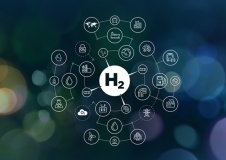Hydrogen Detection
Hydrogen is the lightest element in the periodic table and the most abundant chemical substance in the Universe. Each hydrogen molecule is made up of two hydrogen atoms. Hydrogen combines with other elements, forming a number of compounds such as water, ammonia and methane. Hydrogen is an energy carrier and has no carbon. Upon burning, it only produces water, which makes it a clean, emissions free fuel.
Hydrogen is found in the greatest quantities as water. It is present as a gas in the atmosphere only in tiny amounts – less than 1 part per million by volume. Any hydrogen that does enter the atmosphere quickly escapes the Earth’s gravity into outer space. Most hydrogen is produced by heating natural gas with steam to form syngas (a mixture of hydrogen and carbon monoxide). The syngas is separated to give hydrogen. Hydrogen can also be produced by the electrolysis of water.
Applications
Some see hydrogen gas as the clean fuel of the future – generated from water and returning to water when it is oxidised. Hydrogen-powered fuel cells are increasingly being seen as “pollution-free” sources of energy and are now being used in some buses and cars. Although most propulsion systems are extremely safe and thoroughly tested, additional safety can be obtained by adding a hydrogen detector within the engine compound.
Hydrogen also has many other uses. In the chemical industry it is used to make ammonia for agricultural fertiliser and cyclohexane and methanol, which are intermediates in the production of plastics and pharmaceuticals. In the glass industry hydrogen is used as a protective atmosphere for making flat glass sheets. In the electronics industry it is used as a flushing gas during the manufacture of silicon chips. The low density of hydrogen made it a natural choice for filling balloons and airships. However, it reacts vigorously with oxygen (to form water) and its future in filling airships ended when the Hindenburg airship caught fire.
Selecting a Hydrogen detector
There are two distinct styles of hydrogen detectors: Electrochemical (low, ppm range) and Catalytic (high, LEL lower explosive limit) detection. Selecting the right detector depends on your application and environmental conditions. As experienced gas detection equipment manufacturer, we are often able to assist in this process and select the right hydrogen gas detector should this be an option to reduce your risk associated with hydrogen emissions. Our hydrogen detectors are designed to monitor low levels of hydrogen such as in battery rooms, fuel cell applications and any other environments where hydrogen is present. Contact us for more information.
Gas Specifications
- Gas Name: Hydrogen
- Formula: H2
- CAS No.: 1333-74-0
- TWA: none
- LEL: 4 %
- Density relative to air: 0.03



